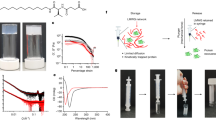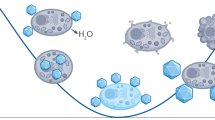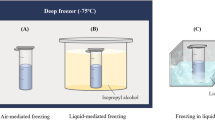Abstract
IN 1953 Lovelock showed that the damage caused to human red blood cells by freezing and thawing could be correlated with the high concentrations of sodium chloride produced in the liquid phase as ice forms1. Subsequent work showed that the actions of glycerol in protecting cells against damage during freezing2 were probably associated with “buffering” the concentrations of salt, for haemolysis first takes place during freezing at a temperature at which a mole fraction of sodium chloride of 0.014 is reached whatever the concentration of glycerol3.
This is a preview of subscription content, access via your institution
Access options
Subscribe to this journal
Receive 51 print issues and online access
$199.00 per year
only $3.90 per issue
Buy this article
- Purchase on SpringerLink
- Instant access to full article PDF
Prices may be subject to local taxes which are calculated during checkout
Similar content being viewed by others
References
Lovelock, J. E., Biochim. Biophys. Acta, 10, 414 (1953).
Polge, C., Smith, A. U., and Parkes, A. S., Nature, 164, 666 (1949).
Lovelock, J. E., Biochim. Biophys. Acta, 11, 28 (1953).
Lovelock, J. E., and Bishop, M. W. H., Nature, 183, 1394 (1959).
Jacobs, M. H., Glassman, H. N., and Parpart, A. K., J. Cell. Comp. Physiol., 11, 479 (1938).
Smith, A. U., Lancet, ii, 910 (1950).
Farrant, J., J. Physiol., 178, 1 (1965).
Florio, L., Stewart, M., and Mugrage, E. R., J. Lab. Clin. Med., 28, 1486 (1943).
Strumia, M. M., Colwell, L. C., and Strumia, P. V., J. Lab. Clin. Med., 56, 576 (1960).
Doebbler, G. F., and Rinfret, A. P., Biochim. Biophys. Acta, 58, 449 (1962).
Jacobs, M. H., Ann. NY Acad. Sci., 50, 815 (1950).
Meryman, H. T., in Cryobiology (edit. by Meryman, H. T.), 63 (Academic Press, London, 1966).
Bricka, M., and Bessis, M., CR. Soc. Biol. Paris, 149, 875 (1955).
Glauser, S. C., and Talbot, T. R., Amer. J. Med. Sci., 231, 75 (1956).
Meryman, H. T., Nature, 218, 333 (1968).
Sloviter, H. A., Fed. Proc., 17, 313 (1958).
Sloviter, H. A., Nature, 193, 884 (1962).
Mazur, P., in Cryobiology (edit. by Meryman, H. T.), 289 (Academic Press, London, 1966).
Nash, T., in Cryobiology (edit. by Meryman, H. T.), 206 (Academic Press, London, 1966).
Jellinek, H. H. G., and Fok, S. Y., Kolloid-Zeitschrift und Zeitschrift für Polymere, 220, 122 (1967).
Rapatz, G., and Luyet, B., Biodynamica, 10, 149 (1968).
Farrant, J., Nature, 205, 1284 (1965).
Author information
Authors and Affiliations
Rights and permissions
About this article
Cite this article
FARRANT, J. Is there a Common Mechanism of Protection of Living Cells by Polyvinylpyrrolidone and Glycerol during Freezing?. Nature 222, 1175–1176 (1969). https://doi.org/10.1038/2221175a0
Received:
Issue date:
DOI: https://doi.org/10.1038/2221175a0
This article is cited by
-
Effects of nanographene oxide on adipose-derived stem cell cryopreservation
Cell and Tissue Banking (2024)
-
Polyvinylpyrrolidone (PVP) Mitigates the Damaging Effects of Intracellular Ice Formation in Adult Stem Cells
Annals of Biomedical Engineering (2010)
-
Identification of new cryoprotective agents for cultured mammalian cells
In Vitro (1983)
-
Cryoprotective effects of Polyvinylpyrrolidone and dextran in the preservation of murine bone marrow cells
Blut Zeitschrift für die Gesamte Blutforschung (1974)



